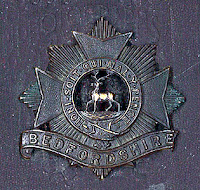Wednesday 24th November 1915: Here at Colchester – where we form
part of 6th (Reserve) Infantry Brigade – we completed our training and have
sent out drafts as reinforcements to both 6th and 7th Battalions. One cannot
help saying that these drafts have invariably been described by Officers
Commanding the Rest Camps where they go prior to joining their new unit as the
best they have had sent to them. Similar praise has been received from the
Officers Commanding units they have joined and from officers who have returned
from the front.
The majority
of our men appeared to be Hertfordshire men, towns like Saint Albans, Hertford,
Watford and Hitchin being well-represented while Harpenden, Radlett,
Buntingford, Letchworth, Berkhamstead etc. have their representatives. Most of
the Bedfordshire men come from Bedford and district and Luton but some come
from Dunstable, Sandy and villages on the borders of Bedfordshire and
Northamptonshire. Huntingdon was well represented and, curiously enough, there
was a section from Bristol(1).
A large
number of the officers are Bedfordshire and Hertfordshire men, Bedford Grammar
School having four representatives and Saint Albans School three and these, not
including many who live in the counties, but who were educated outside.
Four officers
have been killed – Captain J A Tennant (a nephew of Mr Asquith), Lieutenant J T
Adair, Lieutenant W A Leland and Second Lieutenant F C Casswell (who lost his
life in the “Royal Edward” Transport)(2). Others from the Battalion have gone
to take their places, to carry on the good work they have begun, and to maintain
the glorious record which the Bedfordshire Regiment as a whole has earned for
itself in this war.
Every
encouragement is, and always has been, given to the playing of all games after
parade hours. Last year we were unbeaten at hockey; this summer we lost only
one match – the first of the season – at cricket, and we beat that side (9th
Battalion, Royal West Kents) twice later on in the season. At soccer and hockey
we are undefeated this year and although there has only been one rugger match
to date the side shows promise of being a good one. It must not be forgotten
that, owing to the Battalion being draft-producing, the personnel of the side
is constantly changing.
Concerts and
entertainments are frequently given in the evenings and they are very popular
with all ranks.
The songs we
sing on the march naturally change from time to time. At Dovercourt the
favourite was, perhaps “Who’s Your Lady Friend?” but other popular ones were
“Come on Tommy, Come on Jack” (sung to everybody we passed in mufti(3)), “Hold
Your Hand Out Naughty Boy” (for which we had our own verses), “Are we
Downhearted? No”. Others were added while at White City and now our repertoire
is quite a big one. The song which is most popular with the civilian population
is as follows:
We are the
Bedford boys,
We are the
Bedford boys,
We know our
manners,
We spend our
tanners,
We are
respected wherever we go,
When we’re
walking down the broadway lines,
Doors and
windows open wide,
We are the
boys to drink our ale,
Out of a pint
pot or a pail,
We are the
Bedford boys.
And then, Mr.
Kaiser (to the tune of Mr Cupid) is a good second.
Mr. Kaiser,
Mr. Kaiser,
He’s the
cause of all our trouble,
Cause of all
the crime,
When the
Bedfords get to France,
They will
make the beggars dance,
Oh! It’s all
through Mr. Kaiser every time(4).
Source: Bedfordshire Times 26th
November 1915
(1) Nine men
from Bristol would die with the 7th Battalion alone during the course of the
war.
(2) RMS Royal
Edward was sunk on 13th August 1915 by UB-14 off the Greek island of
Kandeloussa, 864 men were drowned; John Amherst Tennant died on 22nd August
1915 in Gallipoli attached to 1st Battalion, Border Regiment; John Thomas Adair
died on the same day serving with the same regiment. Walter Alfred Leland died
in Gallipoli on 4th June 1915 serving with 1st Battalion, Royal Dublin
Fusiliers.
(3) Civilian
clothes
(4) 10th
Battalion, Bedfordshire Regiment would move back to Dovercourt in March 1916
and on 1st September be converted into 27th Training Reserve Battalion, later 27th
Young Soldier Battalion. From 27th October 1917 it would become 53rd (Young
Soldier) Battalion, Bedfordshire Regiment.



















